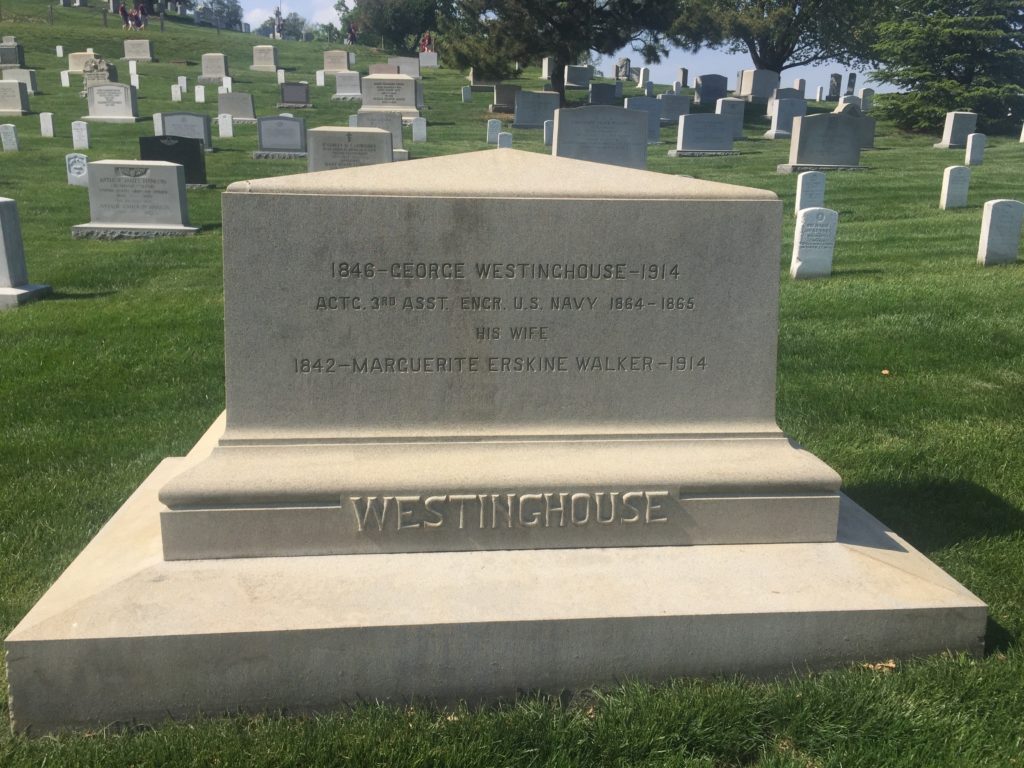Erik Visits an American Grave, Part 555
This is the grave of George Westinghouse.

Born in 1846 in Central Bridge, New York, Westinghouse volunteered for the Civil War when he was just 15, against his parents wishes. They convinced him to return home for a time, but he joined again in 1863 and ended up a corporal in the New York 16th Cavalry and then switching to the Navy, which was something you could do in those days. He briefly went to Union College after the war, but found it boring and dropped out. Instead, he took his interest in tinkering with machines and made a life out of it.
By the time he was 19, Westinghouse was inventing new forms of engines, first the rotary steam engine and then the Westinghouse Farm Engine, which was a little portable steam engine to run threshing machines and the like. Westinghouse also solved a big problem. See, early trains didn’t really have proper brakes. In the late nineteenth century–and this is not an exaggeration–about 200,000 Americans died in various forms of train accidents, which was about as many as died in Civil War battles, which is much lower than total Civil War deaths that were mostly from disease. Many of these railroad casualties were workers, some were passengers, quite a few were people on the street trying to cross the tracks, often getting stuck because of the terrible maintenance. One of the big issues is that train brakemen had to go from car to car to apply brakes to each one. When the train was moving, this was a hell of a good way to die. So in 1869, Westinghouse built a new train braking system that used compressed air. This became universally adopted by the railroads within a few years and made Westinghouse a rich man. He was 22 when he invented it.
By the 1880s, Westinghouse was involved in electrical systems and came up with the modern alternative current system that was far better than the DC system Thomas Edison had created (and patented of course). The AC system was a huge improvement and made Westinghouse even richer. The Westinghouse Electric and Manufacturing Company was created in 1885 and an empire was soon born. Over the next several years, battles between Edison and Westinghouse over their electrical systems became famous. Westinghouse generally won, but Edison helped create General Electric as the main competition. The two companies would bid for control over the American electrical market through the end of the 19th century, both in terms of technological advancement, undercutting each other’s bids on contracts, and of course labor costs. They finally came to a patent-sharing agreement in 1896 that ended the costly war.
Westinghouse was into all sorts of other stuff too–mining engineering, electrical power plants, turbines for marine propulsion, heat pumps, and even tried to build a perpetual motion machine. After cars were invented, he invented shock absorbers.
For a Gilded Age capitalist, Westinghouse was not generally horrible toward labor. He was certainly no friend of unions (remember that, even if it was long after his death, what is today popularly seen as the Rosie the Riveter image was part of an anti-union campaign at Westinghouse), but he at least considered himself a labor progressive. As such, he did things such as voluntarily lowering work weeks as early as 1869, when he cut the hours in his air brake company to 55 a week. He definitely had his company towns and with the normal control of a capitalist over it, but unlike someone such as George Pullman does seem to have at least sort of cared about worker welfare and provided them some pretty solid housing that they could eventually own instead of being kicked out of at any time. He welcomed visitors to his factories and allowed pictures and such. He felt he had nothing to hide. But let’s be clear–he wasn’t having any of them filthy unions. During a 1903 strike led by the International Association of Machinists, he brought in scabs and refused to hire most of the workers back when the strike failed. Welfare capitalism only went so far and that limit was always workers demanding any power of their own.
Westinghouse did however frequently get himself overextended through his investments, lavish houses, and risks on new technologies. The financial crisis of 1907 did him in and he was removed from active management of his company at that time. He was only 60, but his health was declining. He died in 1914 at the age of 67. His wife died three months later.
George Westinghouse is buried on the confiscated grounds of the traitor Lee, Arlington National Cemetery, Arlington, Virginia.
If you would like this series to profile other major inventors, you can donate to cover the required expenses here. Westinghouse was inducted into the National Inventors Hall of Fame in Akron (northeast Ohio’s greatest tourist attraction…) in 1989. The only other member of his class who has a grave is John Deere, buried in Moline, Illinois. Going forward a year, 1990 inductee and punch card inventor Herman Hollerith is in Washington, D.C. Previous posts in this series are archived here.


